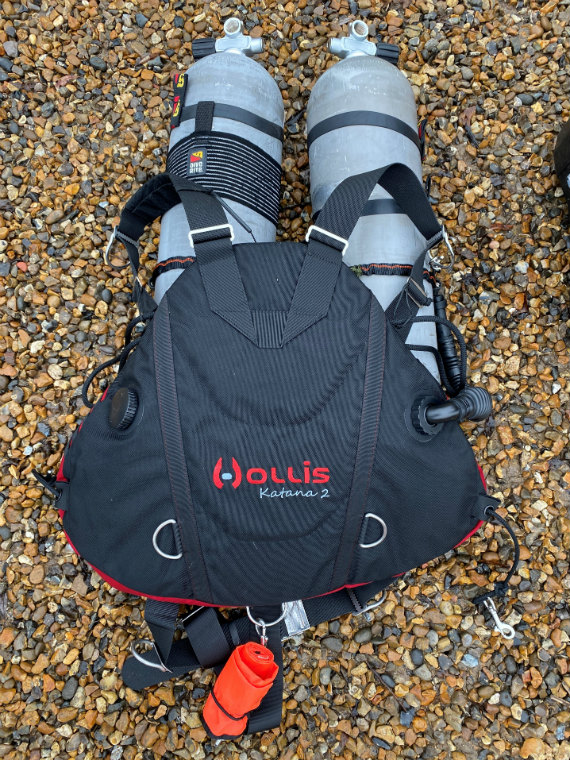Hollis Katana 2 review
Aquanaut Scuba school puts the flexible sidemount system through its paces
The Hollis Katana 2 was designed in collaboration with cave divers, with adjustment, flexibility and adaptability in mind. James Bertram reports.
We at Aquanaut Scuba and Snorkelling Centre Ltd. have just tried the Katana 2 Sidemount wing over the last two days, whilst teaching a PADI Sidemount Diver course at Wraysbury Dive Centre. We previously had two very quick dives in it before the last COVID-19 ‘lockdown’ in England, so this was a better opportunity to evaluate the its pros and cons and reach a considered view.
Conditions for the dives were cold (1 – 3oC air and 7oC fresh water) with heavy cloud and fog, so visibility was very limited with very poor light – hence the lack of underwater pictures. Drysuits with heavy base layers and dry-gloves were essential, with the consequent limitations on mobility and dexterity.
Quick Fit System (Q.F.S.)… very easy to adjust for divers of different heights
First up, we have to mention the colour. Some technical divers may be put off by the fact that it is not all black (!), but we found the red flashes on the sides of the bladder quite stylish. They also aided visibility of the diver in the poor light conditions.
We love the Hollis Q.F.S. (Quick Fit System). The other leading sidemount wings on the market require (at best) adjusting multiple straps, or even the use of tools to change the length of the back piece for divers with different heights, especially when the weights are integrated onto the spine. This can be time consuming and a nightmare on the water’s edge in freezing conditions. In contrast, the Hollis Q.F.S. on the Katana 2 with its innovative use of Velcro loops made it very quick and easy to adjust the harness to divers of different heights. The waist band is a conventional 2-inch webbing with buckle adjustments.
The other key design feature that we think will make the Katana 2 especially suitable for us in a teaching scenario is the ability to move from a more conventional ‘Y’ harness, where the shoulder straps attach to the waist at the back, to an ‘H’ configuration, with the shoulder straps fixed at the front with a small chest strap, more like a recreational BCD. This is a feature that will make the harness very suitable for those divers who have larger waistlines and find it tricky to keep the waistband from slipping below the waist – especially with the additional weight on the waistband when carrying sidemount cylinders on land. This feature alone is enough to persuade us to introduce the Katana 2 to our school teaching equipment.
The four spine-mounted weight pockets easily cope with 3kg lead blocks, providing plenty of capacity for the weight needed when diving in a drysuit with thick base-layers and more buoyant aluminium 11.1L cylinders. The fact that there are four pockets also means that weight can be moved up or down the spine to achieve that ‘perfect horizontal trim’ so beloved of sidemount divers!
We dived the wing with the standard bladder which has a generous 40lb lift capacity. In our view, this makes it easily capable of being used with two stages in addition to the main cylinders (with a drysuit for redundancy). The bladder is encased in a very tough-looking nylon cover which will protect it from sharp stones when placed bladder-down on the ground, as some students are prone to do. Despite its capacity, the wing is well-shaped and not prone to turtle impersonating back bulging or manta-ray impersonating corners lifting when filled with air.
The low-pressure inflator can be configured to fit on the left or right hand sides to suit personal (or dive agency) preference. In addition to the LPI there is a dump valve in the lower left corner with a dangling cord-pull and a central upper dump with the pull-cord routed to the left shoulder, above the D-ring. We understand that the upper dump is a requirement of CE approval (another manufacturer had to recall their bladders for this reason) but we found that students moving to sidemount diving for the first time found this a more convenient and conventional way to deflate the bladder than the flat-on-the-surface method usually required. Another ‘plus’ for school use.
The supplied D-rings on the sides of the waistband are not fixed. We found them to be tricky to use in the water with thick gloves when moving the cylinders to the lower attachment point. We swapped them out for 45-degree welded D-rings for the last two days of our test and were much happier. Another manufacturer uses ‘sliding D-rings’ rather that clipping and unclipping to different attachment points – so this can also be an option depending on choice.
The D-rings mounted on the back corners of the bladder were not used during this trial, since we found them just too fiddly without more practice. We are more used to using a ‘butt pack’ which we understand is an optional extra with the Katana 2.
Overall, we enjoyed using the Katana 2 and will be introducing it to our school equipment. Given the bladder capacity, we would also consider using it for personal dives too.
The Hollis Katana 2 costs £529.95 RRP (single bladder) or £659.95 (dual bladder). For more info visit www.hollis.com. To learn with Aquanaut Scuba visit www.aquanautscuba.co.uk or call 020 8546 8882.










